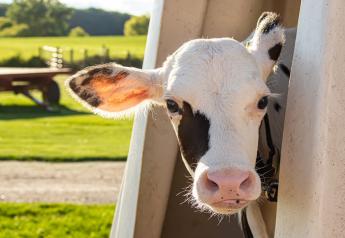Will April’s Record Milk Production Dampen Price Recovery?

April's record milk production isn't the best news for a dairy price recovery, market analysts said today after the release of USDA's monthly Milk Production Report.
Dairies in all 50 states produced 16.385 billion pounds of milk during April 2010, an increase of 1.5% over year-earlier levels, according to today's report. That's the highest-ever volume for April milk production.
states produced 16.385 billion pounds of milk during April 2010, an increase of 1.5% over year-earlier levels, according to today's report. That's the highest-ever volume for April milk production.
The higher milk output "is a little disturbing,” said Dr. Robert Cropp, agricultural economist and professor emeritus at the University of Wisconsin. "There had been predictions earlier in the year for stronger milk prices with the fall in milk production. With this report, it looks like there's plenty of milk, and the anticipated price recovery won't be nearly as strong.”
"The report will have bearish implications for milk futures and the cheese market,” commodity trader Robin Schmahl of AgDairy LLC said.
"We're now seeing the real intent of farmers,” said Schmahl. "They've been seeing better futures prices this year, and they want to make up for lost time and lost income. They can cash-flow at current price levels, and they will push production as hard as they can. But that will work against what lower prices were trying to accomplish last year.”
Both Schmahl and Cropp pointed to the rebound in Western states, particularly California. Although California's April 2010 production remained basically unchanged over year-earlier levels at 3.434 billion pounds, it is significant that it did not continue to curtail its milk output. The Golden State cut production a hefty 4% in 2009, no small amount for the nation's No. 1 milk producer.
California's slight increase of 100,000 lbs. reflected its first production gain in 17 months, noted Alan Levitt in today's Daily Dairy Report from the CME Group. Levitt also said April's overall U.S. milk production number "was considerably higher than trade estimates.”
Other Western States that boosted production in April include Idaho, up 3.3%; Oregon, up 3.1%; and Washington, up 6.2%.
That increase in milk output is partly the result of cheaper feed and continuing adjustments to streamline production costs. At the same time, cow numbers, heifer inventories and per-cow production have risen. "Heifer numbers are 2% higher than a year ago,” said Cropp.
California's dairy industry, which may have suffered the greatest financial stress during 2009, saw a sharp decline in cow numbers last year, down 48,000 cows or 2.6%. But the state's increase in per-cow production last month "is enough to offset the decline in cow numbers,” Cropp said. "California still had 69,000 fewer cows than a year ago in April, or 3.8% less, but this was offset by 3.9% more milk per cow.
"This report tells me that California is coming back,” added Cropp.
Across the U.S., the 2010 average all-milk price could still climb to USDA's estimated $15/cwt. level, well above last year's $12.00/cwt. average mark, Cropp said. But, with rising milk production, the milk price average could tip closer to the higher end of $14/cwt., rather than approach the $16/cwt. level many had hoped to see, he added.
Neither is today's report good news for stronger cheese prices, Cropp and Schmahl said.
Cheese prices have traded lower this year under the pressure of a large inventory. They have recently stayed in the range of $1.38/lb. to $1.51/lb., Schmahl said. Levels could drop to $1.30/lb. since "some buyers will say they don't have to be that concerned” about adequate supplies.
With today's milk production report, "we may begin to see a cat-and-mouse game, with cheese sellers being more aggressive and buyers more cautious,” added Schmahl.
Catherine Merlo is Western editor for Dairy Today. You can reach her at cmerlo@farmjournal.com.







